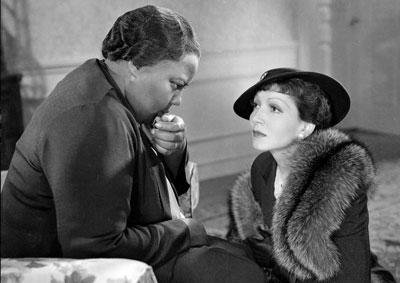Directed by John Stahl
Renowned for its early Westerns and horror films, Universal also laid substantial groundwork for the melodrama in a series of films directed by John M. Stahl, three of which made such a strong impression that they were remade by Douglas Sirk in the 1950s (Imitation of Life, Magnificent Obsession and When Tomorrow Comes, which became Interlude).
While Sirk’s movies are known for Technicolor expressiveness, Stahl’s power lay in his restraint; his camera’s cool, lingering gaze mapped the byways of emotional turbulence with open sincerity. Imitation of Life, based on Fannie Hurst’s 1933 novel, focuses on single mother Bea (Claudette Colbert), who successfully markets her Black maid Delilah’s (Louise Beavers) pancake recipe but fails to improve the plight of Delilah’s daughter, Peola (Fredi Washington), who “passes” for white. Though it’s suffused with stereotypes—most obviously in its appropriation of the servile and superstitious “mammy” figure—it’s an earnest attempt to address racial tensions in its day. The assertion that Peola was born into a world prejudiced against her is skillfully and compassionately wrought.
The film brims with memorable supporting players (look for Ned Sparks as the crusty and clownish businessman Elmer Smith), but Black actress Fredi Washington makes a particularly strong impression as Peola. With her magnetic screen presence and a carefully modulated anxiety, Washington conveys her character’s dilemma with clear, tragic force. “You don’t know what it’s like to look white and be Black,” she tells Bea. Unlike the character she plays, however, Washington, later a journalist and social activist, proudly bore her ethnicity throughout her career and co-founded the Negro Actors Guild of America in 1937.
In addition to its racial drama, the film touches admirably on women’s independence. As the rags-to-riches entrepreneur, the always charismatic Colbert shifts easily from working class exasperation to society glamor, but her confidence and self-sufficiency remain central. Exploring issues of career, motherhood and romance through its female protagonists, the film helped establish the “weepie” as a substantial genre.
—Doug Cummings
Universal Pictures. Producer: Carl Laemmle Jr. Based on the novel by Fannie Hurst. Screenwriter: William Hurlbut. Cinematographer: Merritt Gerstad. Editor: Philip Cahn, Maurice Wright. Cast: Claudette Colbert, Warren William, Rochelle Hudson, Ned Sparks, Louise Beavers.
35mm, b/w, 116 min.






 Mobile Navigation
Mobile Navigation

